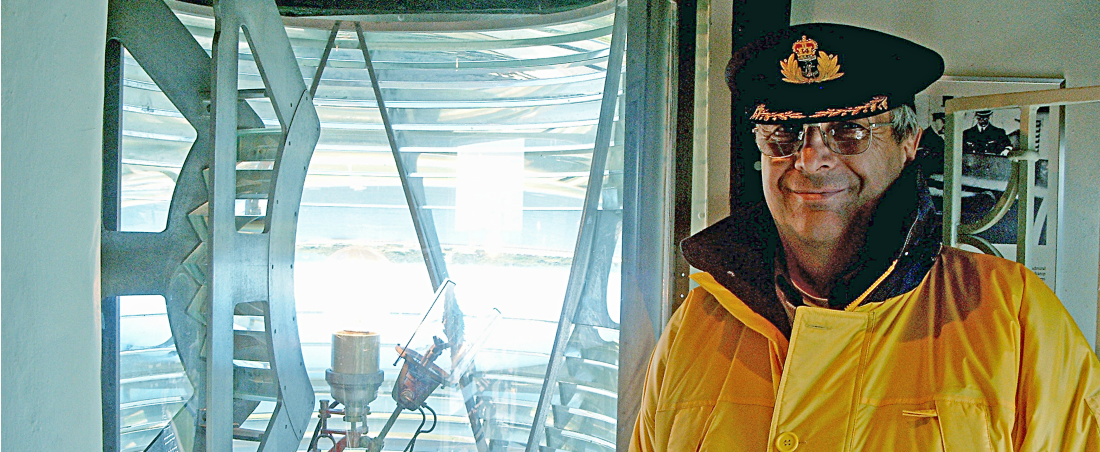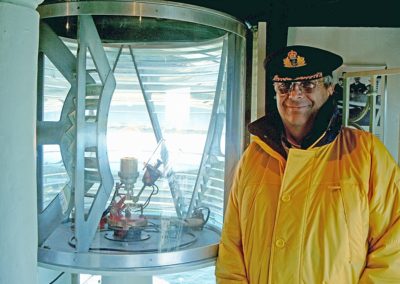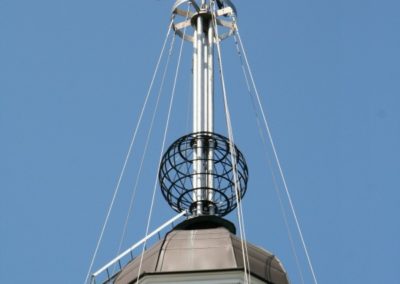
T HE LIGHTHOUSE KEEPER
On the one hand he’s a practical engineer, but on the other – a romantic and a sculptor. In 2001 he bought and refurbished the Gdańsk Nowy Port lighthouse. The investment made no economic sense at all, but it became the most important project of his life. His charisma was inherited from his father, Professor Stefan Michalak, a medical doctor and naval officer, who after the War rebuilt the medical Academy of Gdańsk. Both, father and son, albeit in different professions, shared a passion for the sea.
Stefan Jacek Michalak, the son of Professor Stefan Michalak, is an engineer, physicist, traveller, sculptor and writer. His professional life has been involved with radio telecommunications, and he has installed radio systems in the far north and in Saudi Arabia.
For forty years he has lived in Montreal, but also has a flat in Gdańsk Chełm. Since becoming the owner of Nowy Port Lighthouse he has spent half the year in Poland and the other half in Canada.
He has several duties as lighthouse keeper. Every day, first thing in the morning, he hoists the flag of Gdańsk. Next he starts up the time ball, the 1000-watt lighthouse lamp and the reflectors fitted into panels that illuminate the museum displays. He also switches on a recording of the sound of the sea for visitors. For the next eight hours he is on hand for the visitors who want to hear about the history of the lighthouse and climb the 114 steps. He stamps commemorative documents and gives out various kinds of informative material. Finally he locks the building, takes down the flag and goes home for dinner.
“The lighthouse was meant to be the fulfilment of my dreams, but it became my life’s project”, laughs Jacek Michalak. “I returned here, to the sea, where I was brought up and spent my childhood, because all who are born on the coast long for it their whole life long. That was the case with me and with my father.”
” All who are born on the coast long for it their whole life long. That was the case with me and with my father.”
– Jacek Michalak
Michalak considers Gdańsk his home city, having arrived here with his parents from Warsaw on 8th April 1945 as a eighteen-month-old boy, and the sea is in his blood. His grandfather Szczepan Michalak was born in 1900 into a family of village wheelwrights in Stary Gród in Greater Poland (Wielkapolska) in the south. At the age of eighteen he emigrated to the large northern German city and port of Kiel, where he lived and worked for the following two decades. He became there a master of artistic carpentry. His great artistic and organisational talents brought him, a Pole among Germans, to the position of director of carpentry at Howaldt-Werft, the largest of the Kiel shipyards. Those were the days when beautifully appointed saloons, captain’s cabins and officers’ messes, executed using wood from rare and exotic trees, were the pride of every shipyard in the world. In 1919, after the rebirth of independent Poland, Szczepan Michalak returned to the country of his birth and worked as an instructor in artistic joinery in the State School of Decorative Arts (later the Higher School of Fine Art), Poznań. His son, the father of Stefan Jacek Michalak, Dr Stefan Michalak, after completing medical studies at Poznań in 1933, sailed on many well-known Polish vessels as ship’s doctor. These included Warszawa and Dar Pomorze (including her voyage to the Galapagos, Tahiti and Cape Horn) and the transatlantic liners Piłsudski and Batory. During the occupation of Poland he worked as a medical epidemiologist at the State Department of Hygiene in Warsaw, and in April 1945, acting on behalf of the Polish government, arrived in Gdańsk while it was still burning. Here he became an organiser and the first director of the City Hospital, out of which grew the Medical Academy of Gdańsk, the first of its kind in Poland, of which he was a co-founder. He died a heroic seaman’s death in 1947, hastening to the rescue of two people drowning in the Baltic Sea. The memorial to him, one of the most attractive in Gdańsk, today adorns the square named after him in front of the main building of the Medical University of Gdańsk. Halina, the mother of Stefan Jacek, had also sailed on the transatlantic liner Piłsudski as a nurse.
Stefan Jacek Michalak studied electronics at the schools of technology in Gdańsk and Warsaw, followed by several years working as an engineer and seaman in Germany, before moving permanently to Canada in 1969. There he lived in Montreal, a beautiful city with a population of three million. He also had a summer house at Rivière-du-Loup, where the St. Lawrence River falls into the Atlantic Ocean, reaching a width of 25 kilometres and a depth of 30 metres. On both banks and on the island in its stream rise beautiful lighthouses. For years Michalak looked at these, even if only glancing at them through a window. He loved looking at them because, as he says, they symbolise to him all that is best about human beings: the desire to warn of danger, the desire to save in a disaster, the desire to bring help to survivors and the desire to point to a proper way of life. He had begun to visit Poland after the fall of communism, and when he set eyes on the lighthouse at Nowy Port, neglected and ruined but still preserving its former beauty, he told himself, “That’s for me! The lighthouse must be mine!” He already knew then that he wanted it not only to enjoy it himself, but to be able to make it available to all to visit. And his dream has been fulfilled.




